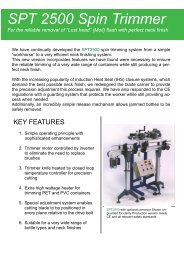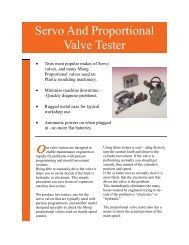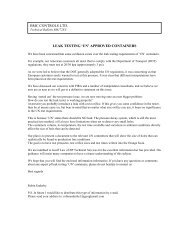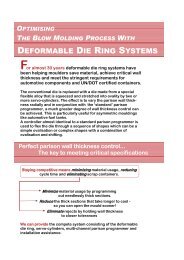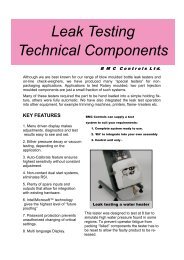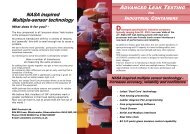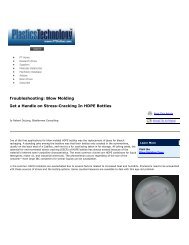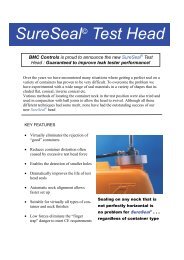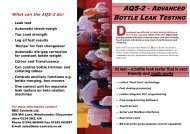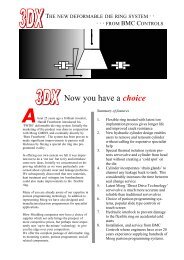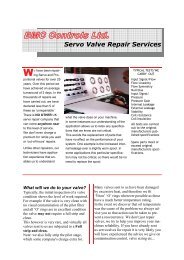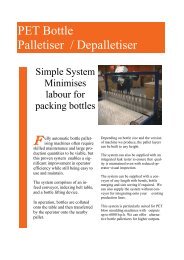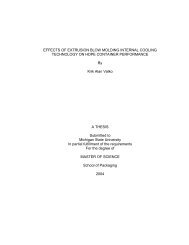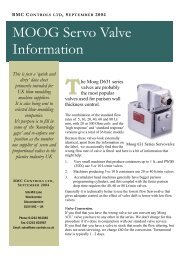Ovalised Tooling for Dairy Bottles - Blow Moulding Controls
Ovalised Tooling for Dairy Bottles - Blow Moulding Controls
Ovalised Tooling for Dairy Bottles - Blow Moulding Controls
Create successful ePaper yourself
Turn your PDF publications into a flip-book with our unique Google optimized e-Paper software.
In ovalized tooling, the shape of the die or mandrel, and in some cases both,<br />
is modified by adding or removing metal in specific areas to selectively decrease<br />
or increase the die gap opening. This modification increased the thickness of<br />
the parison 90 degrees from the mold parting line and decreases the thickness<br />
along the parting halves closing around the parison and results in a bottle with<br />
more uni<strong>for</strong>m wall thickness. Figure 2 shows, in an exaggerated way, how the<br />
parison is squeezed together by the mold when it closes, and how the parison<br />
expands when blown. The thinnest areas of a one-gallon milk bottle made by<br />
standard round tooling are the two lower corners opposite the parting line. This<br />
thinning occurs when the parison is pinched off: the bottom areas draw together,<br />
as shown in Figure 3, increasing the distance the parison must be blown to contact<br />
the mold surface.<br />
Figure 3. Parison drawn together by pinch-off<br />
PARISON<br />
<strong>Blow</strong>-up to corner<br />
increased by<br />
pinch-off action<br />
To maintain sufficient thickness in these thin lower corners with standard<br />
round tooling, the overall bottle weight must be increased. This increase also<br />
results in excess polymer in all the areas along the parting line – and increased<br />
cost. Ovalized tooling distributes more polymer to the areas of the parison experiencing<br />
the greatest blow-up. More polymer is blown to the corners 90 degrees<br />
from the mold parting line than to other parts of the bottle. With optimized ovalized<br />
tooling, all four corners have equivalent thickness. The bottom line is that a<br />
bottle made with standard round tolling would have to be substantially heavier to<br />
match the per<strong>for</strong>mance properties of a bottle made with ovalized tooling.<br />
EVALUATION METHOD<br />
To evaluate the effects of ovalized tooling, one of the two central heads of a<br />
UNILOY* 350 R2 four-head blow molding machine was fitted with an ovalized die,<br />
while standard round tolling remained on the adjacent head. Molds and blowing<br />
mandrels were identical. The ovalized die used was a “shelf item” with 0.003 inch<br />
ovalization, available through UNILOY (Part number 865821).<br />
A PETROTHENE ® high density polyethylene resin (melt index = 0.65 g/10 min.;<br />
density = 0.959+ g/cm 3 ), specifically designed <strong>for</strong> high speed production of<br />
thin-walled containers, was used in this evaluation. <strong>Bottles</strong> with target weights of<br />
53, 55, 57, 59, 61, 63, and 65 grams were produced on each of the two blow<br />
molding heads. <strong>Bottles</strong> used <strong>for</strong> this evaluation fell within 0.2 grams of the target<br />
weight; bottles with handle webbing or resin folds were discarded; and parison<br />
swing was held to a minimum. Based on the parameters, ten bottles from each<br />
*UNILOY is a registered trademark of Johnson <strong>Controls</strong>, Inc.<br />
3



